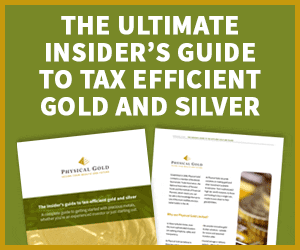Blog
Physical Gold preferred to pooled assets in any investment portfolio
By Luke Jackson (Intelligent Partnership)
“Why is physical gold not held in every investment portfolio?”
The price of gold over the last 10 years, and most notably since the start of the current financial crisis, has outperformed virtually every other available asset class with average (real) returns of over 25% per annum. Despite this performance, gold is still seen as a luxury good and one that is out of reach for the run of the mill investor.
A recent survey of 1,000 investors undertaken by the US based precious metals provider Gold Bullion International LLC (GBI) identified the types of assets investors hold as part of their investment portfolio. The survey looked at the investments currently held and their attitude towards investing in physical assets such as gold. As well as being essential market research for physical gold suppliers, the results of this survey also highlight the lack of understanding many investors have for investing in physical gold and the role it can play in their portfolio.
Download our FREE 7 step cheat sheet to buying physical gold here
Survey Results:
The survey highlighted increasingly strong demand for investment in gold, be it through physically held assets or pooled investment vehicles. More than half of respondents (63%) saying that they would like to own a physical asset like gold coins or bullion as part of their investment portfolio. A further 29% said they would prefer to invest in the gold market through pooled, non-physical assets like gold stocks and mutual funds.
In contrast only 2% of those questioned currently own investment grade gold. This in itself represents a huge gap between those who believe in gold as an asset class and would like to invest, and those who have taken the steps to hold physical gold in their portfolio. A large number of investors (44%) felt that they did not know enough about physical gold as an investment asset and therefore had not seriously considered including it in their portfolio. Investors felt that gold is too difficult to purchase (37%) with 22% of respondents not knowing how or where they can purchase gold.
With the correct marketing and support there is huge potential in the market for physical gold companies, with more than half of those questioned in the survey (51%) saying that they would own physical gold bars or coins if recommended to them.
How gold should be used in an investment portfolio:
A small allocation of gold can help to balance a portfolio and be used as a hedge against inflation and more volatile investments such as stocks and shares. The World Gold Council (WGC) recommend that adding a discrete allocation of gold, between 3 & 7% can allow a portfolio to achieve the same returns but with a much lower degree of risk. Some analysts now believe that, with the Eurozone crisis and the threat of further Quantitative Easing (QE) in the US, up to 25% of an investors’ portfolio should be held in gold, with a further 25% in cash and the remaining split between riskier traditional investments. Gold can have the role of a “Safe Haven” asset, as it is not controlled by Governments, is in very limited supply and will always have a value, unlike stocks, shares or paper currency.
Ways of investing in gold:
Exchange Traded Funds (ETFs), gold funds and shares in mining companies give investors exposure to gold and are all influenced by the performance of the spot price of gold. These options tend to be heavily geared, and therefore can allow for largest gains and losses than the actual change in the spot price of gold. Added to this, there is also counterparty risk, liquidity risk and management charges, which all can have an impact on potential profits and the suitability of holding these types of gold investments.
Futures are another option for investors, although are particularly risky and therefore are usually only used by sophisticated and speculative investors, rather than those looking for long term portfolio growth or security. Futures allow physical gold to be purchased in advance, with a price being agreed on for a specific date in the future. Movement either side of this price can result in gains or losses for both the buying and selling party. A further option is spread betting, which allows an investor to speculate on the price of gold and effectively put a bet on where they feel it may move to. This is a very short term investment strategy and investors can stand to lose more money than their initial investment amount.
Physical gold as an asset:
A common view among investors and advisors is that physical gold is a luxury investment, and one that is out of reach from the general public. This is by no means true, with a number of companies now offering the opportunity for investors to purchase physical gold in the form of investment grade bars and coins. Investment grade bars are at least 99.5% pure gold, with coins such as the British Sovereign and Britannia being at least 91% pure gold.
Physical gold as an investment asset can have many advantages overexposure through ETFs, gold funds, mining shares and spread betting. It is a highly liquid asset, with a global market meaning that there are always willing buyers. Supply of gold is finite, with no major new discoveries within the last 10 years and growth in supply averaging less than 2% per year. This can make a huge difference in contrast to holding paper money, which is controlled by the Government and has seen a huge recent influx of supply as seen with Quantitative Easing (QE).
Gold is also highly divisible as coins or bars can be sold off individually or in bulk, adding to the liquidity of physical gold as an investment. Finally, as gold is a real physical asset it creates a feeling of emotional attachment and security which can rarely be seen with traditional investments.
How available is physical gold?
A number of companies offer physical gold as an investment and work with financial advisors and introducers to educate investors on the value that holding physical gold can bring to a well-diversified investment portfolio. There are a number of companies in the UK that offer investment grade gold bars and coins which can be held privately by investors or stored on their behalf, by independent precious goods storage companies such as ViaMat International. The aim behind this is to make physical gold a more common place investment, allowing investors to purchase just as easily as they would traditional investment such as stocks or company shares.
Conclusion:
Owning physical gold as part of a well-diversified investment portfolio should be a consideration for all levels of investors. There are a number of physical gold companies that offer investors a safe and secure gold investment, which can be held personally or by a third party and provide security and diversification, offsetting the risk posed by traditional investments.




